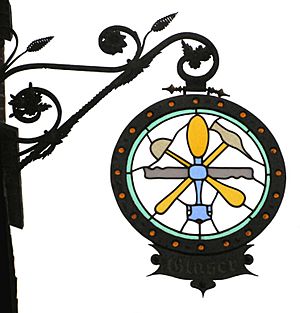Guild facts for kids
A guild was a special group of people. These groups were made up of skilled workers or business owners. They worked together to control their specific craft or trade in a town. Think of them as early versions of professional organizations.
Many different types of groups began as guilds. This includes groups of scholars and even religious groups. Some modern organizations, like universities, also started out as guilds. The main goal of a guild was to manage how a trade was taught and practiced. They made sure that the quality of work was high.
In Europe, kings and queens often gave guilds special powers. Young people who wanted to learn a trade would become an apprentice. They would work for a master craftsman for several years, sometimes as long as seven years. After their training, they could become full members of the guild. Then, they could start their own business and even train their own apprentices. This system was common in Europe until the early 1900s.
What Kinds of Guilds Were There?
There were many different kinds of guilds. For example, there were guilds for weavers and dyers who worked with wool. There were also guilds for masons and architects who built things.
Other common guilds included:
- Painters
- Blacksmiths (who worked with metal)
- Bakers
- Butchers (who prepared meat)
In London, England, some old guilds still exist today. They are called "livery companies." The senior members of these companies have an important job. They help choose the Lord Mayor of London and other city officials.
When Were Guilds Important?
Guilds were very common and powerful in the Middle Ages. This was a time from about the 5th to the 15th century. They helped organize towns and ensure good quality work.
However, their influence started to decrease around the 1700s and 1800s. Some thinkers, like Jean-Jacques Rousseau and Adam Smith, did not like guilds. They believed that guilds made it harder for the economy to grow. They also thought guilds stopped free trade. Free trade means people can buy and sell goods without many rules or limits.
Images for kids
-
The Syndics of the Drapers' Guild by Rembrandt, 1662.
-
One of the legacies of the guilds: the elevated Windsor Guildhall originated as a meeting place for guilds, as well as a magistrates' seat and town hall.
-
Coats of arms of guilds in a town in the Czech Republic displaying symbols of various European medieval trades and crafts
-
A center of urban government: the Guildhall, London (engraving, c. 1805)
-
Locksmith, 1451
-
Shoemakers, 1568
See also
 In Spanish: Guilda para niños
In Spanish: Guilda para niños











